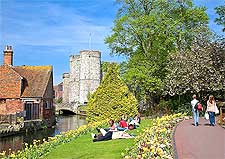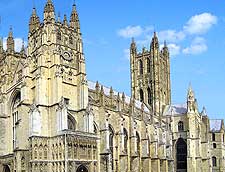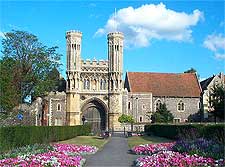Canterbury History Facts and Timeline
(Canterbury, Kent, England, UK)

First established by the Romans 2,000 years ago, the Kentish cathedral city and former pilgrimage destination of Canterbury is best known for its long involvement in the religious, political and secular history of England.
The very first Archbishop of Canterbury was St. Augustine, the founder of Christianity in Kent, with this coveted position as head of the English church becoming a political prize during the medieval and later eras.

The Cathedral
Construction of the great cathedral, the heart of the ancient city and one of the most notable churches in Christendom, was begun in 597 AD and is now, along with its surrounding old city, a UNESCO World Heritage site. St Augustine also founded the Augustinian Abbey, outside the city walls, which was for many centuries the final resting place of successive archbishops.
After massive rebuilding in 1070 AD following Viking raids, the medieval religious centre of the old city and its cathedral became a Europe-wide pilgrimage centre after the political martyrdom in the cathedral of St. Thomas a Becket, ordered by King Henry II. The king's exasperated comment, 'Who will rid me of this turbulent priest?' is as much a part of the city's history as the magnificent building itself.

The Canterbury Tales
The Canterbury Tales, penned by medieval author Geoffrey Chaucer in 1387 and one of the earliest English literary works, tells of a group of pilgrims on their journey from
London to Canterbury, giving a fascinating glimpse into 14th-century English life. The King's School, reputedly also founded by St. Augustine in 597 AD, is the oldest such school in the world, set in ancient buildings and still functioning. Canterbury yeomen were active during the English Civil War in 1647, especially when the Puritan mayor banned Christmas Day church services, causing city-wide riots.
The ancient heart of Canterbury and its cathedral have, over the centuries, seen much rebuilding and renovation, suffering extensive bomb damage during WWII. Happily, an attempt at unsuitable development of the city centre after the war was thwarted by residents and the glories of the old town still remain. Today, every era, from Roman through Norman and medieval, gives a journey back in time for visitors from across the world.
 First established by the Romans 2,000 years ago, the Kentish cathedral city and former pilgrimage destination of Canterbury is best known for its long involvement in the religious, political and secular history of England.
First established by the Romans 2,000 years ago, the Kentish cathedral city and former pilgrimage destination of Canterbury is best known for its long involvement in the religious, political and secular history of England.
